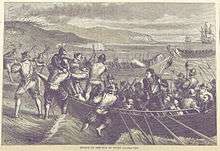French invasion of the Isle of Wight

The French invasion of the Isle of Wight occurred during the Italian Wars in July 1545. The invasion was repulsed.
France had a long history of attacking the Isle of Wight, and the 1545 campaign proved to be the last time to date that the French have attempted to take it.[1] Although the French forces, led by Claude d'Annebault,[2] greatly outnumbered those of the English, the battles fought (including the battles of the Solent and Bonchurch) ended without a clear winner. However, as the French were repelled, it could be considered an English victory.[3] Although the operation was inconclusive, the English suffered heavily, including the loss of the carrack Mary Rose in the Battle of the Solent.[4] Details of the conflict have not been very well recorded, and some accounts claim that the French were defeated at each battle rather easily.[5]
French strategy was to effect a landing at Whitecliff Bay and cross Bembridge Down to attack Sandown, and another landing at Bonchurch with a view to marching to link up at Sandown. The northern force was intercepted whilst crossing the Down, but fought its way to Sandown Castle, which was then under construction offshore. Both forces were repulsed after stiff fighting. The event is commemorated by a plaque in Seaview which reads: "During the last invasion of this country hundreds of French troops landed on the foreshore nearby. This armed invasion was bloodily defeated and repulsed by local militia 21st July 1545".
The veracity of this account has been challenged by the Isle of Wight Historical Review, pointing out that there were few if any local inhabitants and the militia may have been sent from the mainland and that the numbers involved are uncertain. Contemporary accounts suggest that the French (or their mercenaries) sacked the area in order to provoke the English Fleet into battle against a far larger fleet. The settlement at Nettlestone and its manor were burnt.

Of the invasion Martin Du Bellay wrote: "...To keep the enemy's forces separated, a simultaneous descent was made in three different places. On one side Seigneur Pierre Strosse was bidden to land below a little fort where the enemy had mounted some guns with which they assailed our galleys in flank, and within which a number of Island infantry had retired. These, seeing the boldness of our men, abandoned the fort and fled southwards to the shelter of a copse. Our men pursued and killed some of them and burned the surrounding habitations..."
A later account from Sir John Oglander says: "...They landed at three several places at one time, purposely to divide our forces. Pierre Strosse landed at St Helens where there was a little fort, and beat our men, being divided from the fort, into the woods. Le Seigneur de Tais, General of the Foot, landed at Bonchurch, where there was a hot skirmish between them and us, and on either party many slain..."
The French seem to have landed at undefended points and then attacked defences from inland. At Whitecliff Bay and at Bonchurch they moved swiftly to seize the high ground. However the attacks were expected and in both cases local forces reached the high grounds to oppose them.
At Bonchurch the French landed easily at Monk's Bay, but were then faced with the difficulty of breaking out from what is known descriptively as the "Undercliff". Their solution was to ascend the extremely steep slopes of St Boniface and Bonchurch Downs, which are over 700 feet (210 m) high. The defenders thus had them at a considerable advantage, having taken up positions on the top of the hill.
References
- ↑ "Isle of Wight Heritage". April 2009. Archived from the original on 27 October 2005. Retrieved 7 September 2013.
- ↑ Glete, Jan (2000). Warfare at Sea, 1500-1650: Maritime Conflicts and the Transformation of Europe. Routledge. p. 141. ISBN 0-415-21454-8.
- ↑ Murray, John (1876). A Handbook for Travellers in Surrey, Hampshire, and the Isle of Wight. J. Murray. p. 396.
- ↑ Chisholm, Hugh (1911). The Encyclopædia Britannica: A Dictionary of Arts, Sciences, Literature and General Information. Encyclopædia Britannica. p. 627.
- ↑ Rose, John Holland (1909). Dumouriez and the Defence of England Against Napoleon. J. Lane Company. p. 47.